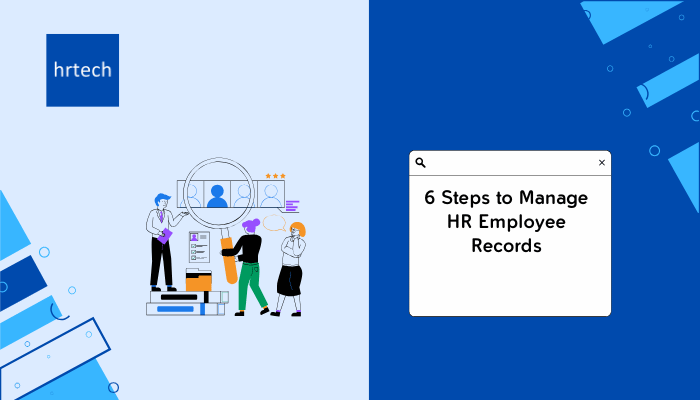Effective HR records management is essential for smooth human resources operations. It involves organizing, storing, and securing important employee documents like tax forms, contracts, and performance reviews. Managing these records correctly helps your company follow laws and regulations while avoiding legal risks. Laws such as the Fair Labor Standards Act (FLSA) and Health Insurance Portability and Accountability Act (HIPAA) set rules on how employee data must be handled. Having a good system in place ensures that records are easy to access and that your HR tasks run efficiently.
Proper HR records management also protects employee privacy, improves data security, and reduces unnecessary work. Using the right tools, HR departments can organize records better, prevent data leaks, and automate tasks like finding documents and keeping them for the right amount of time. This guide will show you six key steps to manage HR records effectively, helping you keep information safe, stay compliant with laws, and improve overall HR operations.
What is Employee Records Management, and Why is it Important for HR?
Employee records management refers to the systematic process of collecting, storing, maintaining, and organizing various documents related to employees throughout their employment lifecycle. This includes a wide array of documents such as employment contracts, tax forms, performance reviews, attendance records, benefits information, and disciplinary actions. The primary goal of HR records management is to ensure that all employee-related information is accurate, up-to-date, secure, and easily accessible when needed.

- HR plays a key role in managing these records. Effective applicant tracking management enables HR departments to maintain a clear and accurate history of each employee’s interactions with the company, from the point of hire through their departure.
- Properly managing these records assure compliance with labor laws, streamlines administrative processes, and reduces legal risks.
- It also protects sensitive employee data, preventing unauthorized access and ensuring that information is stored securely.
Why is Effective HR Records Management Important?
HR records management is crucial for several reasons:
Compliance with Legal and Regulatory Requirements
Organizations must adhere to various federal, state, and industry regulations that dictate how long employee records must be retained, who can access them, and how they must be protected. Regulations like the Fair Labor Standards Act (FLSA), Health Insurance Portability and Accountability Act (HIPAA), and the General Data Protection Regulation (GDPR) have specific requirements that businesses must follow to avoid fines and legal consequences. Ensuring HR compliance through proper HR records management is essential for staying legally protected.
- Retain records for mandated periods (e.g., payroll, tax, medical).
- Control access based on role and job function.
- Implement regulatory-specific data management protocols.
- Regularly review legal updates to adjust compliance measures.
- Avoid legal penalties by ensuring adherence to record retention laws.
Data Security and Privacy
Employee records contain sensitive information, including social security numbers, financial details, and medical data, which must be carefully protected. Proper HR records management involves securing this data so only authorized personnel have access. Implementing data security measures like encryption, multi-factor authentication, and role-based access controls helps prevent breaches and unauthorized access, protecting both the employee and the organization.
- Encrypt sensitive employee data security for additional protection.
- Use role-based access controls to limit data visibility.
- Implement secure cloud storage or physical security for paper records.
- Regularly audit access logs to detect any unauthorized access.
- Train employees on data security best practices to reduce risks.
Improved Administrative Efficiency
A structured HR records management system boosts efficiency by allowing HR teams to quickly access, update, and organize records. HR Automating tasks like document retrieval and retention tracking reduces manual work, freeing up HR resources to focus on more strategic initiatives. Administrative efficiency improves overall operations and reduces errors, making HR processes more seamless.
- Automate document retrieval to reduce manual search times.
- Set up workflows to update records automatically.
- Use software to track document expiration and compliance deadlines.
- Organize records for easy access based on department or record type.
- Reduce paper usage and space by moving to digital recordkeeping systems.
Legal Protection and Risk Mitigation
Maintaining a comprehensive HR records management system is crucial for protecting a company during audits, lawsuits, or disputes. Proper documentation provides a clear trail of employment actions, making it easier to defend the organization in legal scenarios. By keeping accurate and well-organized records, companies can mitigate risks related to wrongful termination claims or wage disputes.
- Keep records of employment decisions like promotions and terminations.
- Maintain up-to-date payroll and attendance records.
- Assure audit trails for every record to track changes and access.
- Use records as evidence in legal disputes or audits.
- Regularly review records for accuracy and completeness to avoid future issues.
How Effective HR Records Management Impacts Business Success
The following table outlines the critical areas where efficient HR records management positively influences business performance. From streamlined operations to scalability, proper management enhances decision-making, reduces costs, and improves employee engagement.
| Impact Area | Description |
| Streamlined Operations and Better Decision-Making | Organized HR records allow quick access to data, supporting faster and more informed decision-making in areas such as promotions, restructuring, and compliance. |
| Enhancing Employee Experience and Engagement | Efficient HR records management Assure timely responses to employee inquiries (e.g., payroll, benefits), improving overall employee satisfaction and engagement. |
| Reducing Overhead Costs | Transitioning to digital record systems reduces physical storage costs, minimizes paperwork errors, and saves administrative time, ultimately lowering operational costs. |
| Ensuring Scalability | A scalable HR records system adapts to business growth and changes in workforce size or regulations, ensuring continued efficiency and compliance as the company expands. |
Benefits of Employee Records Management
Effective employee records management provides a range of benefits for businesses, ensuring smooth operations and reducing potential risks. Here are five key advantages:
1. Assure Compliance with Federal Laws and Record Requirements:
Proper management of HR records assure that the organization complies with federal, state, and industry-specific regulations such as the Fair Labor Standards Act (FLSA) and the General Data Protection Regulation (GDPR). By adhering to these requirements, companies avoid legal penalties and ensure lawful retention and handling of employee data.
2.Provides Legal Protection during Audits and Lawsuits:
Well-maintained employee records offer legal protection during audits or lawsuits. Accurate documentation can help defend against claims related to wrongful termination, wage disputes, or discrimination by providing evidence of company policies and procedures.
3. Enhances Security and Privacy of Sensitive Data:
Managing employee records with security in mind assure the protection of sensitive personal information, such as social security numbers and medical records. Implementing access control, encryption, and secure storage practices helps to safeguard this data from breaches and unauthorized access.
4. Increases Administrative Efficiency:
Streamlined records management reduces the time HR departments spend searching for, updating, or retrieving employee documents. HR automating processes and keeping records organized, businesses save valuable time and resources, allowing HR to focus on strategic activities.
5. Facilitates Streamlined Data Flow and Access:
A well-organized records management system assure that relevant information is easily accessible to authorized personnel. This facilitates smoother data flow across departments, supporting better decision-making and faster response times to employee or regulatory inquiries.
6 Steps to Manage HR Employee Records
Managing HR employee records is crucial for ensuring compliance, protecting sensitive data, and streamlining administrative processes. By following these six steps, organizations can effectively organize, secure, and maintain employee records while improving operational efficiency and reducing legal risks.

Step 1: Map Your Employee Records
To create an effective HR records management system, start by mapping out all necessary employee records. This includes identifying the various documents that need to be collected and managed throughout an employee’s lifecycle, such as hiring documents, tax forms, performance reviews, disciplinary records, and benefits information. Properly mapping these records assure comprehensive and organized tracking of employee data. It also helps in meeting legal compliance requirements and facilitates easy access for authorized personnel.
- Identify key documents: employment contracts, W-2s, I-9s, insurance forms, etc.
- Include both digital and paper records, if necessary.
- Assure records cover the entire employee lifecycle, from onboarding to termination.
- Review regulatory requirements for maintaining specific records.
- Create a master list of document types for all HR operations.
Step 2: Define Access Needs
Once the necessary records have been identified, the next step is to define access needs within your organization. Not every employee or department needs access to every type of record, so it’s important to determine who should have access to specific information. By setting access needs, you assure that sensitive employee information is only available to those with a legitimate reason for accessing it.
- Determine access based on roles (e.g., HR, management, IT).
- Limit access to sensitive records, such as payroll and medical data, to specific personnel.
- Implement role-based access control (RBAC) systems.
- Set up approval processes for higher-level access when necessary.
- Regularly review and update access permissions to ensure ongoing security.
Step 3: Identify Retention Requirements
Different types of records have various retention requirements, as mandated by federal, state, and industry-specific regulations. Identifying and setting retention timelines assures that documents are kept for the appropriate amount of time and disposed of properly when they are no longer needed. This not only helps with compliance but also reduces the amount of outdated data stored in your system.
- Identify retention requirements for different types of records (e.g., payroll records for 3 years, tax records for 7 years).
- Set clear expiration dates for each document type.
- Automate triggers to archive or delete records when their retention period ends.
- Consider industry-specific regulations when determining retention timelines.
- Keep audit trails of disposed records to maintain transparency and accountability.
Step 4: Determine Security Level
Security is a critical aspect of HR records management. Employee records often contain sensitive information, so it’s essential to evaluate the security needs of each document type and implement appropriate security measures. Different types of records may require different levels of security depending on their sensitivity.
- Assess the security needs for various records (e.g., payroll data, medical information).
- Implement encryption for digital records, especially sensitive ones.
- Use multi-factor authentication (MFA) for access to confidential files.
- Assure that physical records are stored in secure, locked environments.
- Regularly update security protocols to address evolving cyber threats.
Step 5: Establish Storage and Archiving Plan
Decide how and where to store your HR records, whether in digital format, physical format, or both. The decision will depend on factors such as ease of access, security, and compliance requirements. A clear storage and archiving plan ensures that records are kept organized and easily retrievable when needed while maintaining security and regulatory standards.
- Choose between physical storage, digital storage, or a hybrid approach.
- Organize records by department, type, or access point for easier retrieval.
- Use cloud storage solutions with encryption for digital records.
- Develop an archiving strategy for records that are no longer in active use but still need to be retained.
- Regularly back up digital records to protect against data loss or breaches.
Step 6: Implement Your Plan with HR Management Software
HR management software can significantly streamline the process of managing employee records. Implementing software that supports automation, secure storage, and easy access will help your organization stay organized and compliant. These systems also offer features like document expiration tracking, access logs, and security audits.
- Choose HR software that supports automated record tracking and retention schedules.
- Incorporate features such as document expiry reminders to ensure timely archiving or deletion.
- Use software that provides role-based access control to protect sensitive data.
- Assure the software includes encryption and audit trails for security compliance.
- Regularly update software to take advantage of the latest security and feature enhancements.
Conclusion
A well-structured HR records management system provides critical benefits such as ensuring compliance with legal regulations, protecting sensitive employee data, and improving administrative processes. By organizing and automating employee records, businesses can mitigate legal risks, safeguard personal information, and significantly increase operational efficiency, allowing HR teams to manage employee data with greater ease and accuracy.
Such a system offers enhanced control over records, streamlining access to vital information, and reducing the time spent on manual document management tasks. This improved control and efficiency lead to a more productive HR department, enabling teams to focus on strategic goals rather than routine paperwork.
With the integration of hrtech, businesses can further optimize their HR records management by leveraging automation, digital security features, and intuitive tools that simplify complex tasks. HR software solutions not only keep businesses compliant but also provide scalable and secure systems for efficient records management.
Contact us today to improve your HR records management system, enhance compliance, and boost overall organizational efficiency.





